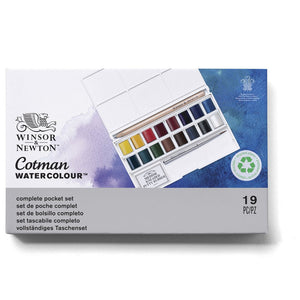
What is watercolour?
Watercolour is a mixture of finely ground pigment suspended in a binder made of Gum Arabic. Other ingredients are added to stabilise the paint, making it is as lightfast as possible, so your work stands the test of time.
What paper should I use and what’s the difference between hot press and cold press?
Using watercolour paper is key because it is designed to be absorbent; it can withstand large quantities of water without cockling (causing the paper to ripple).The smoothest surface is hot press, which is best for scientific, detailed and hyper-realistic work, whereas cold press has a more textured surface and is great for effects like granulation and texture.
Best paintbrushes for use with watercolour?
Watercolour brushes are the best as they have soft bristles, making them ideal for working in smooth layers of colour. The size of the brush is crucial depending on what you want to do; the belly of the brush is the widest part and the bigger the belly, the more water and paint can be carried. Smaller brushes are great for detail, but they don’t hold as much water and pigment.
What’s the difference between gouache and watercolour?
In a nutshell, gouache has a higher pigment load than watercolour. Therefore, gouache is great for flat, opaque areas of colour and works well in combination with the transparency of watercolour.
How can I create texture with watercolour?
How you use your brush can add texture. If you work in a ‘dry brush’ technique, using less water, to leave more pigmented, scratchy marks. Alternatively, mediums add texture. Mix in granulation medium to give a mottled appearance to colours which would otherwise appear as a smooth wash or enhance a naturally granulating colour. Granulation medium can be used undiluted, instead of water, for a more pronounced effect. In addition, texture medium makes the dry surface of the colour rough, and Aquapasto medium gives watercolour a thicker, impasto quality.
How do I mask a watercolour painting?
Masking fluid is the best way to mask a painting; any area, no matter how delicate, will be protected from subsequent layers of colour with masking fluid. Then, when the paint is dry, gently rub off the masking fluid with your finger to uncover the layer underneath.
How can I use pens with watercolour?
Pens and watercolours are fantastically compatible, drawings made with fineliners are ideal for making a sketch as a first step before colour, or for adding details on top of watercolour later. The juxtaposition of line with washy colour makes for a lovely contrast. Fineliners come in a variety of nib sizes, allowing for lines that run from subtle to bold.
How do I use watercolour pencils?
Watercolour pencils can be used in three ways: as a coloured pencil, to create drawings that can be transformed later with water, or the tip can be dipped in water before drawing. Some people like the slightly different texture to a watercolour pencil over a traditional coloured pencil, so they just use them to draw. The real beauty of these pencils though is in the versatility that comes from transforming marks in pencil to watery washes while leaving other areas of the drawing as they were drawn, with the two textures working together. Dipping the tip in water creates soft lines, another option to the mark-making potential of this one tool.
What’s the best beginners’ watercolour set?
The best set for beginners must be the Cotman Watercolours Deluxe Sketchers' Pocket Box because it has everything needed to start enjoying watercolour; it includes 16 colours to allow for some great mixes, a travel brush, pencil for sketching out your composition and a kneaded putty rubber.
What watercolour set would you recommend for practicing artists?
The best set for practicing artists is the Professional Watercolour Complete Travel Tin - 24 Half Pans; it has all the most exciting colours and can travel around the world with you. It has two mixing areas due to the fold out, double lid closure.
How can I find out more about watercolour?
Check out our Masterclass videos and our range of watercolour guides.


